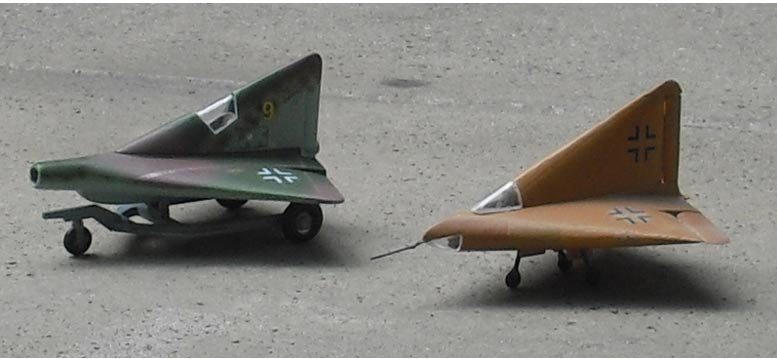Above: Lippisch P.13 models.
In 1944 Nazi Germany was out of fuel. Luftwaffe gave orders to Dr.Alexander Lippisch (1894-1976) to create a new, very fast interceptor that could challenge the Allied bombers and fighters. The answer was P. 13, the coal-burning interceptor prototype that should use coal particles as fuel. The idea was a revolutionary design that used a coal-burning ramjet engine as a power source. The ramjet engine that used certain-size coal particles worked. But then the Second World War ended.
And these radical aircraft and engine designs are forgotten. The problem with a ramjet engine is it must have a certain speed. Before, it can ignite the fuel that is injected into the engine. When the ramjet travels fast enough, it forms a pressure front in the engine.
In 1944, engineers planned to use rockets to accelerate ramjet. To a speed. That was high enough for ramjet ignition. But there is the possibility of creating airspeed in the engine by putting the aircraft into a wind tunnel or pulling air through the ramjet. When ignition happens in the ramjet the hangar hatces will open or the air tube must separate from the exhaust tube. The aircraft will run to the runway immediately and lift off.
That pressure raises the temperature high enough that it can ignite the fuel. With some new ideas, the vacuum chamber or supersonic wind tunnel will be used to ignite the ramjet. The idea is that the air pump pulls air through the ramjet. When the airspeed is high enough, the system starts the fuel injection.
The tube will connect to the exhaust tube of the engine and then the system pulls air through the engine. In some other models, the wind tunnel will be in the hangar where the aircraft waits for orders to lift off. When airspeed reaches about Mach 1 the system can inject fuel into Ramjet, and then the aircraft can start running on the runway.
Above. Simple ramjet operation, with Mach numbers of flow shown. (Wikipedia, Ramjet)
There are two ways to use coal as fuel. The first way is to use coal like fullerene into the engine. The other is to use coal gas, or city gas as fuel.
The nano-size carbon particles can combine with oxygen forming CO^2. That thing means that the system uses carbon itself. Or there can be a chamber where coal will turn into coal gas. The common name for that gas is city gas. The aircraft can use liquid coal gas as fuel. The coal gas is normally produced by warming coal. This gas will fit to ramjet fuel.
The problem is how to rmove carbon from the fuel. Modern nanotechnology allows the TNT (Trinitrotrotuluene) nanoballs, that can used as fuel. Or maybe gunpowder nanoballs can be used as fuel in ramjet engines.
The thing that has made hydrogen a so-called bad fuel is that there are no particles that cause pressure against the walls of the chamber. In some models, the system can use water injection in the engine system to increase pressure. Things like nano-silicone bites can also used to make those pressure waves. And there is a possibility to use things like nitrogen crystals or "nitrogen fullerene" ball-shaped molecules there is no carbon for making the fuel, which is more powerful than any time before.
One of the answers would be the nanowater or nano ice. The nano water is the droplet o small ice bite that is water or maybe the hydrogen. The hydrogen ice will be injected into the combustion chamber. This causes expansion and the hydrogen crystal makes the particle that acts like carbon. The nano-droplet would be a very small droplet.
When we think about modern nanotechnology. That allows chemists to create nontechnical fuels like TNT and other explosives that are transformed into nanotechnical forms. Those separated molecules can make it possible to create things like an "extreme version of coal-burning ramjets". Or maybe the next-generation fuel is the nano-size gunpowder. That thing can used to make the revolutionary fuel for ramjet and rocket engines.
XXXXXXXXXXXXXXXXXXXXXXXXXXXXXXXXXXXXXXXXXXXXXXX
"Coal gas, also known as a gaseous mixture, is a fuel made up of hydrogen, methane, and carbon monoxide produced by destructive distillation (continuous heating in the absence of air) of bituminous coal. Coal is mostly made up of carbon, with varying proportions of additional elements such as hydrogen, sulfur, oxygen, and nitrogen. Coal is generated when dead plant matter decays into peat, which is then transformed into coal over millions of years by the heat and pressure of deep burial." (https://byjus.com/chemistry/coal-products/)
The typical composition of the Coal gas is as follows:
Hydrogen 50%
Methane 35%
Carbon monoxide 10%
Ethylene 5%
XXXXXXXXXXXXXXXXXXXXXXXXXXXXXXXXXXXXXXXXXXXXXXX
https://byjus.com/chemistry/coal-products/
https://planehistoria.com/the-lippisch-p-13-was-a-coal-powered-interceptor/
https://en.wikipedia.org/wiki/Alexander_Lippisch
https://en.wikipedia.org/wiki/Coal_gas
https://en.wikipedia.org/wiki/Lippisch_P.13
https://en.wikipedia.org/wiki/Ramjet
https://en.wikipedia.org/wiki/TNT






No comments:
Post a Comment
Note: Only a member of this blog may post a comment.